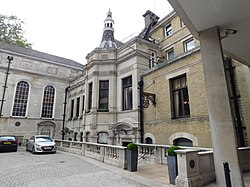Stationers' Hall
| Stationers' Hall | |
|
Middlesex | |
|---|---|
 Stationers' Hall | |
| Type: | Livery hall |
| Location | |
| Grid reference: | TQ31848119 |
| Location: | 51°30’51"N, 0°6’5"W |
| City: | London |
| History | |
| Built 1670 | |
| For: | The Worshipful Company of Stationers |
| Livery hall | |
| Information | |
| Owned by: | The Worshipful Company of Stationers and Newspaper Makers |
Stationers' Hall is the livery hall of the Worshipful Company of Stationers and Newspaper Makers, usually known as the 'Stationers' Company', one of the livery companies of the City of London.
The hall dates from the seventeenth century, having been rebuilt after the Great Fire of London. It stands on Ave Maria Lane near Ludgate Hill and St Paul's Cathedral. This was formerly the site of Abergavenny House, which was purchased by the Stationers in 1606 for £3,500, but destroyed in the Great Fire of London in 1666.[1]
The current building and hall date from c. 1670. It is designated a Grade I listed building.[2]
History
At the time the Stationers' Company received its royal charter in 1557, it was based at Peter's College, which the Company had bought from St Paul's Cathedral. In 1606 though, the Company bought Abergavenny House in Ave Maria Lane for £3,500 and moved out of Peter's College. The new building became its livery hall.
This first Stationers' Hall burnt down in the Great Fire of London of 1666, and with it were lost books to the value of about £40,000.[3]
The hall was rebuilt and its present interior is much as it was when it reopened in 1673. The Court Room was added in 1748. In 1800 the external façade was remodelled to its present form by the architect Robert Mylne.[4]
The Company
The Worshipful Company of Stationers was formed in 1403, as a guild of stationers, which at this time included scribes, lymners (illuminators), bookbinders and booksellers who worked at a fixed location (stationarius) beside the walls of St Paul's Cathedral.[5]
The guild received a royal charter in 1557. Once the company received its charter, “the company’s role was to regulate and discipline the industry, define proper conduct and maintain its own corporate privileges.”[6] It held a monopoly over the publishing industry and was legally empowered to seize 'offending books', through which many of the arguments of the Reformation and the Civil War turned. The Stationers' Company remained officially responsible for setting and enforcing regulations until the enactment of the Copyright Act of 1710 provided explicit protection for authors. The term 'copyright' derives from the former regulation by the Stationers' Company of the right to copy printed works.
In 1937, the Company adopted its current name, by adding 'and Newspaper Makers'.
Although the company has lost its role as a regulator, and exists today mainly for charitable endeavours, its members are mostly involved with the modern visual and graphic communications industries that have evolved from the company's original trades, including printing, papermaking, packaging, office products, engineering, advertising, design, photography, film and video production, publishing of books, newspapers and periodicals and digital media.
Stationers' Hall has hosted the Shine School Media Awards, where students compete in the creation of websites and magazines.
Outside links
| ("Wikimedia Commons" has material about Stationers' Hall) |
References
- ↑ Stationers Livery Company website. Accessed 17 February 2015
- ↑ National Heritage List 1064742: Stationers' Hall
- ↑ Stationers Livery Company
- ↑ Cyprian Blagden (1977) [1960]. "The Property". The Stationers' Company: A History, 1403-1959. Stanford University Press. ISBN 9780804709354. https://books.google.com/books?id=xDysAAAAIAAJ&pg=PA206.
- ↑ Patterson, Lyman Ray: 'Copyright in Historical Perspective' (Vanderbilt University Press, 1968)
- ↑ Lyons, Martyn (2011). Books: A Living History. Los Angeles, CA: J. Paul Getty Museum. pp. 61.
- John Gough Nichols (1861), Historical notices of the worshipful Company of stationers of London, OCLC 5386736, http://openlibrary.org/books/OL6639628M/Historical_notices_of_the_worshipful_Company_of_stationers_of_London
- Sketch of the History and Privileges of the Company of Stationers. 1871. https://books.google.com/books?id=3w8HAAAAQAAJ.
- Murray, J.: Handbook to London as It Is: Stationers' Hall (Murray's Handbooks for Travellers, 1879)
- "Stationers' Hall", London and Its Environs (17th ed.), Leipzig: Karl Baedeker, 1915, http://hdl.handle.net/2027/mdp.39015019440851?urlappend=%3Bseq=150
- Greg, W. W. (1928). The Decrees and Ordinances of the Stationers' Company, 1576–1602.
- Greg, 1W. W.; Boswell, E. (1930). Records of the Court of the Stationers' Company, 1576 to 1602 – from Register B.
- Siebert, Fred S. (1936). "Regulation of the Press in the Seventeenth Century: Excerpts from the Records of the Court of the Stationers' Company". Journalism Quarterly 13: 381–93.
- Blagden, Cyprian (1957). "English Stock of the Stationers' Company in the Time of the Stuarts". The Library 12.
- Jackson, W. A.: 'Records of the Court of the Stationers' Company, 1602 to 1640' (1957)
- Blagden, Cyprian (1958). "Stationers' Company in the Civil War Period". The Library 13.
- Blagden, Cyprian (1959). "Stationers' Company in the Eighteenth Century". Guildhall Miscellany. SSN 0072-8985.
- Cyprian Blagden (1960). The Stationers' Company: A History, 1403-1959. London: Allen & Unwin. OCLC 459559508.
- Myers, Robin; Harris, Michael, eds (1997). Stationers' Company and the Book Trade 1550–1990. Winchester: St Paul's Bibliographies. ISBN 9781873040331.
- Myers, Robin, ed (2001). Stationers' Company: a history of the later years 1800–2000. Chichester: Phillimore. ISBN 9781860771408.
| Livery Halls of the City of London |
|---|
|
Apothecaries • Armourers • Bakers • Barber-Surgeons • Brewers • Butchers • Carpenters • Chartered Accountants • Clothworkers • Coopers • Cutlers • Drapers • Dyers • Farmers & Fletchers • Fishmongers • Founders • Furniture Makers • Girdlers • Glaziers • Goldsmiths • Grocers • Haberdashers • Information Technologists • Innholders • Ironmongers • Leathersellers • Mercers • Merchant Taylors • Painters • Pewterers • Plaisterers • Saddlers • Salters • Skinners • Stationers • Tallow Chandlers • Vintners • Watermen • Wax Chandlers • HQS Wellington • |